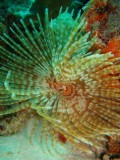This is a common question asked when people board a dive
boat. My answer is it is not required but I encourage it. Let me tell you why.
The other day I asked my friend John if I could relay his
story. He was diving on a new dive site in favorable but less than ideal
conditions. He is actually a great diver although he has only been diving a
short time. Before he got back to the boat he realized he was low on air he
ascended. After inflating his BCD he was really low on air and struggled to get back
to the boat admitting he swallowed a lot of sea water. I noticed that when I
went diving with him this week he had put his snorkel back on his mask.
A few years ago, when I owned a dive shop I read an article
in Alert Diver magazine. It stated some interesting facts. Roughly 80% of all
diving accidents happen to people not wearing a snorkel. At first glance a lot of
you will say well almost 90% of all diving accidents occur at the surface so
that makes sense. But do the math. That means more than 90% of the diving
accidents that occur under water happen to people who don’t wear snorkels. The
point of the article was this “Almost
all diving accidents happen because the diver failed to do something he was taught
in Open Water Class or attempted to do something he wasn’t taught in Open Water
Class.” I will accept that the increase in some of the more technical aspects
of diving within the recreational community has spawned some of this. However,
the point of the article was “A diver
who fails to use a snorkel, a required piece of equipment, has already accepted
that the education provided for him by diving experts doesn’t apply to him all
the time.”
Another day I was diving with a diver who I actually asked
to wear a snorkel. He refused saying he was extremely experienced and assured
me that in his 100 dives he had no need for one. Maybe I should have insisted.
We were doing a scheduleD 40 min. drift dive. The reason for this was that the
most scenic portion of the dive was too dangerous to bring a boat in and the
strong current would have prevented us from returning to the starting point. Instead
of informing me of the exact amount of air he had left when I asked he gave me
the “time out” sign which generally means you have half a tank left. He was
actually below 1000 lbs. Minutes later I saw him heading to the surface where I
joined him. He was struggling to keep his head above water so I hit his
inflator and his tank went dry before I got it filled enough to make him
positively buoyant. I then dropped his weights and orally inflated his BCD the
rest of the way. I asked if he could swim with me away from the dangerous area
so the boat could retrieve us. He said he didn’t think he could because he was
out of air and had no snorkel. I had to tow a 240 lb. diver to safety because
HE didn’t wear a snorkel and HE was experienced enough to not need it.
Apparently he was experienced enough to keep an eye on his air and report it
accurately… NOT!
I have over 8400 dives and if you do the math this means I
have spent almost 2/3 of a year in my life underwater. I always wear a snorkel.
I understand that sometimes a snorkel could be a safety hazard as in cave
diving and wreck diving. It can also be a hindrance for some underwater photographers
and videographers. But, divers like myself may not always be there to rescue
you as in this last story. It’s still your decision but a smart and safe diver
wears a snorkel.
Until next
time always make your total number of ascents equal your total number of
descents.
Your really
cool blogger
Duane.







